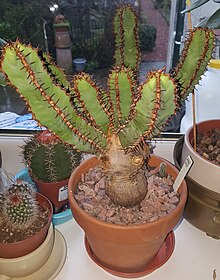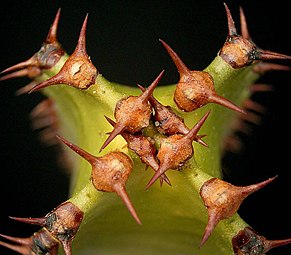Euphorbia canariensis
| Euphorbia canariensis | |
|---|---|

| |
| Canary Island spurge close to the Mirador de Archipenque at Los Gigantes | |
| Scientific classification | |
| Kingdom: | Plantae |
| Clade: | Tracheophytes |
| Clade: | Angiosperms |
| Clade: | Eudicots |
| Clade: | Rosids |
| Order: | Malpighiales |
| Family: | Euphorbiaceae |
| Genus: | Euphorbia |
| Species: | E. canariensis
|
| Binomial name | |
| Euphorbia canariensis | |
| Synonyms | |
|
Euphorbia canariensis Forssk. | |
Euphorbia canariensis, commonly known as the Canary Island spurge, Hercules club
Description
The Canary Island spurge is a succulent shrub, growing to between 3 and 4 metres (10 and 13 ft) high. It is made up of fleshy quadrangular or pentagonal trunks that look like cacti. It has no leaves, instead bearing spines 5 to 14 millimetres (0.20 to 0.55 in) long. It produces reddish-green flowers.[9] It is hardy to −2 °C (28 °F).[11]
The
-
Spines on a young shoot
-
Flowers
-
Fruit

Distribution
The species is found on the narrow coastal belt, from sea level to 1,100 metres (3,600 ft) in the Canary Islands.[13]
See also
References
- . Retrieved 19 November 2021.
- ^ "Appendices | CITES". cites.org. Retrieved 2024-01-17.
- ^ a b "Euphorbia canariensis". Germplasm Resources Information Network. Agricultural Research Service, United States Department of Agriculture. Retrieved 2008-03-22.
- ^ International Plant Names Index. "whole name = Euphorbia canariensis". Retrieved 2008-03-22.
- ISBN 978-90-6191-262-0. Retrieved 2008-03-22.
- Decandolle, A.P. (1837). "Euphorbia canariensis". Plantarum historia succulentarum = Histoire des plantes grasses. Retrieved 2008-03-22.
- ^ Barbara J. Collins, Ph.D. (2007-08-09). "Photographs of succulents Euphorbia canariensis 4744". Photographs of succulents. California Lutheran University. Retrieved 2008-03-23.
- ISBN 978-84-7207-129-2.
- ^ a b "Canary Islands Flora - Arid Habitat". Archived from the original on 2008-03-06. Retrieved 2008-03-02.
- ^ "Símbolos de la naturaleza para las Islas Canarias" [Natural Symbols for the Canary Islands]. Ley No. 7/1991 of 30 April 1991 (in Spanish). Vol. 151. pp. 20946–20497 – via BOE.
- ^ Thijs de Graaf. "Euphorbia". euphorbia engels. Retrieved 2008-03-23.
- doi:10.1016/S0031-9422(97)00018-6. Archived from the originalon 2008-08-07. Retrieved 2008-03-23.
- ^ a b University of Connecticut (18 March 2008). "Euphorbia canariensis L." EEB Greenhouse Accession Data. Ecology & Evolutionary Biology Greenhouses. Retrieved 2008-03-23.
External links
 Media related to Euphorbia canariensis at Wikimedia Commons
Media related to Euphorbia canariensis at Wikimedia Commons- Decandolle, A.P. (1837). "Illustration of Euphorbia canariensis". Plantarum historia succulentarum = Histoire des plantes grasses. Retrieved 2008-03-22.




